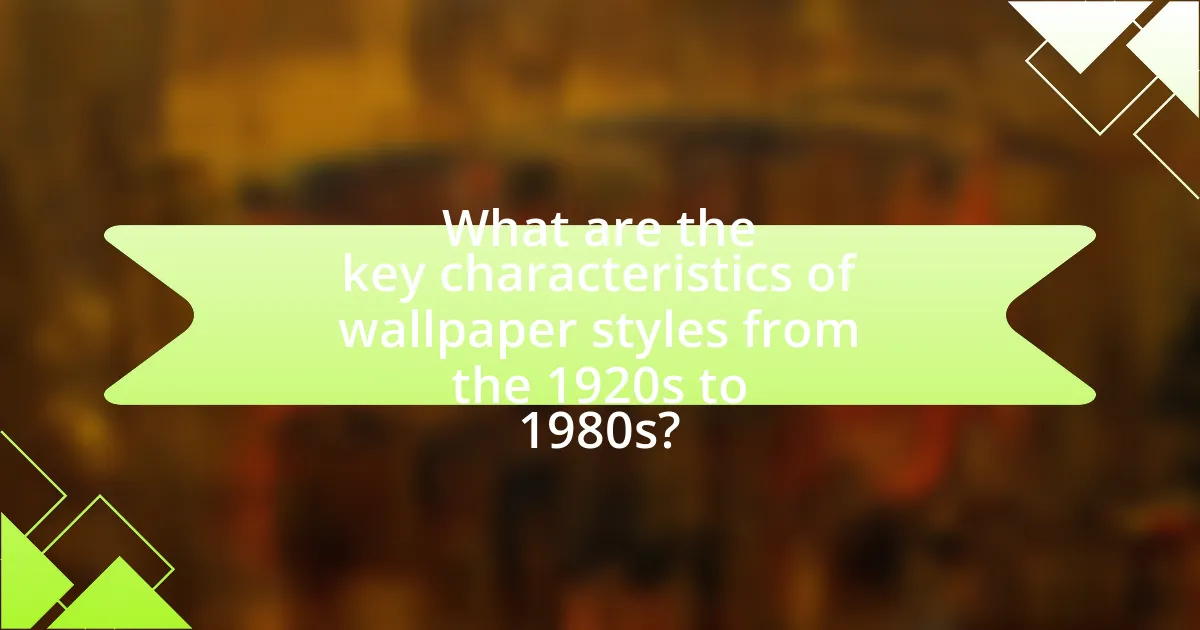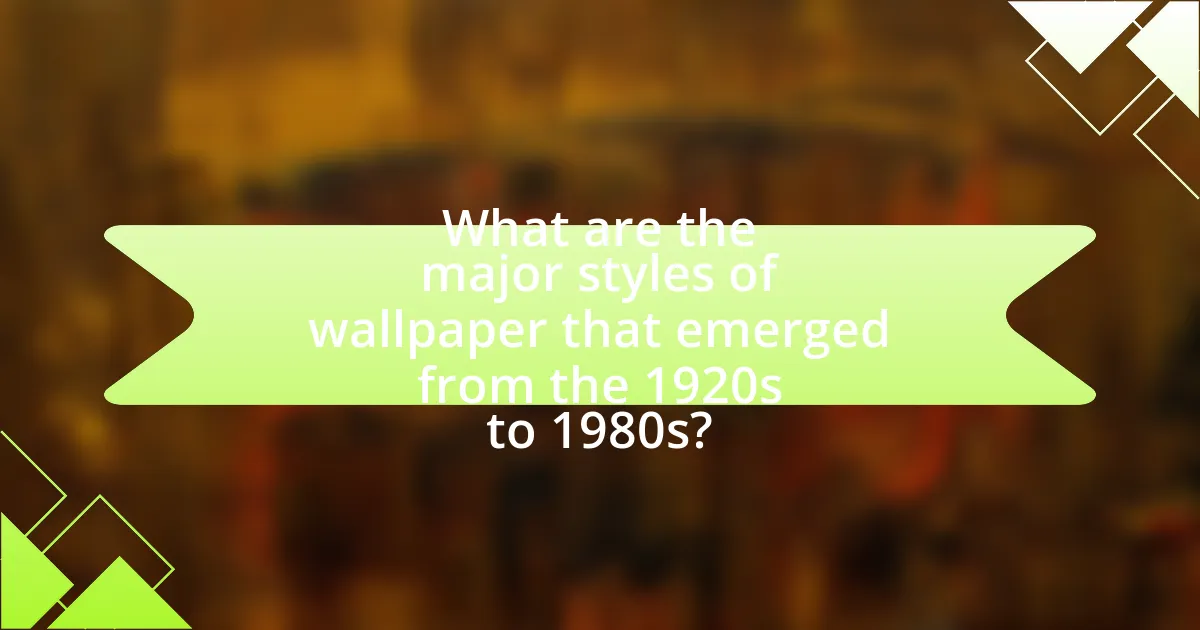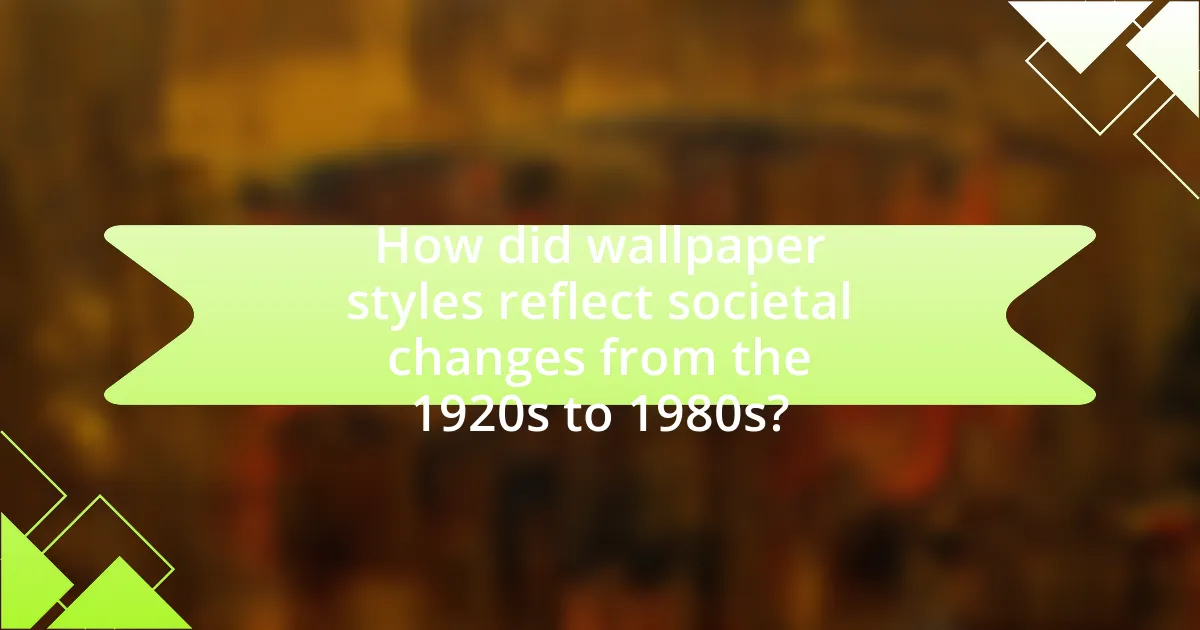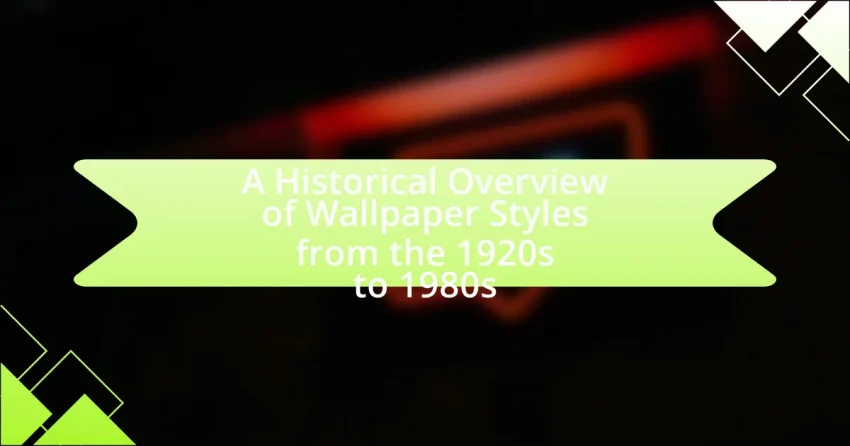The article provides a comprehensive overview of wallpaper styles from the 1920s to the 1980s, highlighting key characteristics and cultural influences that shaped design trends across these decades. It examines the evolution of wallpaper, from the bold geometric patterns of Art Deco in the 1920s to the vibrant psychedelic designs of the 1960s, and the eclectic styles of the 1980s. The discussion includes the impact of historical events, economic conditions, and social movements on wallpaper aesthetics, as well as innovations in materials and printing techniques that transformed production. Additionally, practical tips for incorporating vintage wallpaper styles into modern interiors and considerations for maintenance are addressed, providing a thorough understanding of the historical significance and relevance of wallpaper design.

What are the key characteristics of wallpaper styles from the 1920s to 1980s?
Wallpaper styles from the 1920s to 1980s are characterized by distinct design trends that reflect the cultural and artistic movements of each decade. In the 1920s, Art Deco introduced bold geometric patterns and vibrant colors, often featuring metallic finishes. The 1930s saw a shift towards more subdued colors and floral motifs, influenced by the Great Depression, emphasizing elegance and simplicity. The 1940s embraced wartime practicality, with simpler designs and the use of more durable materials. In the 1950s, mid-century modern styles emerged, showcasing abstract patterns and pastel colors, reflecting post-war optimism. The 1960s and 1970s brought psychedelic and bohemian influences, with bold colors, large-scale prints, and a mix of textures. By the 1980s, wallpaper styles became more eclectic, incorporating a variety of influences, including traditional and contemporary designs, often featuring pastel colors and floral patterns. Each decade’s wallpaper styles not only illustrate aesthetic preferences but also mirror the social and economic conditions of the time.
How did the cultural context influence wallpaper designs during this period?
Cultural context significantly influenced wallpaper designs from the 1920s to the 1980s by reflecting societal values, artistic movements, and technological advancements. For instance, the Art Deco movement of the 1920s emphasized geometric patterns and luxurious materials, mirroring the era’s fascination with modernity and opulence. In the post-World War II period, the rise of suburban living and the baby boom led to the popularity of cheerful, pastel colors and floral patterns, which represented optimism and domesticity. Additionally, the 1960s counterculture movement introduced bold colors and psychedelic designs, reflecting a desire for individuality and rebellion against traditional norms. These shifts in wallpaper design were directly tied to the prevailing cultural sentiments, illustrating how wallpaper served as a visual representation of the times.
What major historical events shaped wallpaper trends in the 1920s?
The major historical events that shaped wallpaper trends in the 1920s include the aftermath of World War I, the rise of the Jazz Age, and the onset of the Great Depression. The end of World War I in 1918 led to a desire for renewal and optimism, reflected in the vibrant colors and bold patterns of Art Deco wallpaper designs. The Jazz Age, characterized by cultural liberation and a break from traditional norms, influenced the use of geometric shapes and luxurious materials in wallpaper. Additionally, the economic challenges of the Great Depression in the late 1920s shifted trends towards more affordable and practical designs, emphasizing simplicity and functionality. These events collectively influenced the aesthetic and material choices in wallpaper during the decade.
How did the Great Depression affect wallpaper styles in the 1930s?
The Great Depression significantly influenced wallpaper styles in the 1930s by shifting trends towards more economical and simpler designs. During this period, consumers faced financial constraints, leading to a preference for wallpapers that featured less intricate patterns and more muted colors, reflecting a desire for practicality and affordability. The use of cheaper materials became prevalent, and many manufacturers produced wallpapers that mimicked more expensive textures, such as wood or fabric, to appeal to budget-conscious buyers. This shift is evidenced by the rise of solid colors and geometric patterns, which were easier to produce and install, aligning with the economic realities of the time.
What role did post-war optimism play in the 1950s wallpaper designs?
Post-war optimism significantly influenced 1950s wallpaper designs by promoting vibrant colors, bold patterns, and themes of prosperity and modernity. This era, marked by economic growth and a desire for a fresh start after World War II, led designers to embrace lively motifs that reflected a sense of hope and renewal. For instance, the use of geometric shapes and floral patterns became prevalent, symbolizing a break from the past and an embrace of a brighter future. The popularity of these designs was further supported by the rise of consumerism and the expansion of the middle class, which fueled demand for decorative home products that conveyed a sense of comfort and style.
How did the counterculture movement of the 1960s influence wallpaper aesthetics?
The counterculture movement of the 1960s significantly influenced wallpaper aesthetics by promoting bold colors, psychedelic patterns, and a departure from traditional designs. This movement, characterized by a rejection of mainstream values and an embrace of artistic expression, led to the incorporation of vibrant motifs and unconventional themes in wallpaper. For instance, the use of swirling patterns and bright hues mirrored the visual language of psychedelic art, which was prevalent in music and visual culture during that era. The shift towards more expressive and eclectic designs in wallpaper reflected the broader cultural changes of the time, as individuals sought to create personalized and unique living spaces that resonated with their ideals of freedom and creativity.
What were the predominant materials used in wallpaper production across these decades?
The predominant materials used in wallpaper production from the 1920s to the 1980s included paper, vinyl, and fabric. In the 1920s and 1930s, paper was the primary material, often featuring intricate designs and patterns. By the 1950s, vinyl became popular due to its durability and ease of cleaning, leading to a significant shift in production methods. In the 1970s and 1980s, fabric wallpapers gained traction, offering texture and a more luxurious appearance, while still incorporating paper and vinyl elements. This evolution reflects advancements in manufacturing techniques and changing consumer preferences throughout these decades.
What innovations in wallpaper materials emerged in the 1920s?
Innovations in wallpaper materials during the 1920s included the introduction of vinyl-coated wallpapers and the use of new printing techniques such as lithography. Vinyl-coated wallpapers offered improved durability and washability, making them more practical for everyday use. The advancement of lithographic printing allowed for more intricate designs and vibrant colors, enhancing the aesthetic appeal of wallpapers. These innovations reflected the broader trends of the era, emphasizing modernity and functionality in interior design.
How did synthetic materials change wallpaper manufacturing in the 1960s?
Synthetic materials revolutionized wallpaper manufacturing in the 1960s by introducing durability, ease of maintenance, and a wider variety of designs. The use of vinyl and other synthetic compounds allowed wallpapers to be more resistant to moisture and stains, making them suitable for kitchens and bathrooms, areas where traditional paper wallpapers would deteriorate quickly. Additionally, synthetic materials enabled the production of vibrant colors and intricate patterns that were previously difficult to achieve, thus expanding aesthetic options for consumers. This shift not only enhanced the functional aspects of wallpaper but also aligned with the growing trend of modernism in interior design during that decade.
What environmental considerations began to influence wallpaper production by the 1980s?
By the 1980s, environmental considerations such as the use of non-toxic materials and sustainable production practices began to significantly influence wallpaper production. Manufacturers started to prioritize eco-friendly inks, adhesives, and substrates, responding to growing public awareness about environmental issues and health concerns associated with traditional wallpaper materials. This shift was driven by increased regulations and consumer demand for safer, more sustainable products, leading to the adoption of water-based inks and the reduction of harmful chemicals in production processes.

What are the major styles of wallpaper that emerged from the 1920s to 1980s?
The major styles of wallpaper that emerged from the 1920s to 1980s include Art Deco, Mid-Century Modern, and Contemporary styles. Art Deco, prominent in the 1920s and 1930s, featured bold geometric patterns and vibrant colors, reflecting the luxury and modernity of the era. Mid-Century Modern, which gained popularity in the 1940s to 1960s, emphasized organic shapes, minimalism, and a connection to nature, often using pastel colors and abstract designs. The Contemporary style, emerging in the late 20th century, showcased a diverse range of patterns and textures, often incorporating technology and innovative materials, reflecting the eclectic tastes of the time. These styles collectively illustrate the evolution of wallpaper design, influenced by cultural and artistic movements throughout the decades.
What defining features characterize Art Deco wallpaper from the 1920s and 1930s?
Art Deco wallpaper from the 1920s and 1930s is characterized by bold geometric patterns, vibrant colors, and luxurious materials. These wallpapers often feature stylized motifs inspired by nature, technology, and ancient cultures, reflecting the era’s fascination with modernity and elegance. The use of metallic inks and embossed textures further enhances the visual impact, making Art Deco wallpaper a distinctive choice for interior design during this period.
How did geometric patterns become popular in Art Deco designs?
Geometric patterns became popular in Art Deco designs due to their association with modernity and technological advancement during the early 20th century. The Art Deco movement, which emerged in the 1920s, embraced bold shapes, symmetry, and streamlined forms, reflecting the era’s fascination with industrialization and the machine age. This style was characterized by the use of geometric motifs, which were often inspired by ancient cultures, nature, and the emerging technologies of the time, such as aviation and automobiles. The popularity of geometric patterns in Art Deco was further solidified by their incorporation into various design elements, including architecture, fashion, and interior design, making them a defining feature of the aesthetic.
What color palettes were typical of Art Deco wallpapers?
Art Deco wallpapers typically featured bold and vibrant color palettes, including rich jewel tones such as emerald green, sapphire blue, ruby red, and deep gold. These colors were often combined with black and white to create striking contrasts, reflecting the luxurious and modern aesthetic of the Art Deco movement that emerged in the 1920s. The use of metallics, particularly gold and silver, was also prevalent, enhancing the opulence associated with this style. This color scheme was designed to evoke a sense of glamour and sophistication, aligning with the overall design principles of Art Deco, which emphasized geometric patterns and streamlined forms.
What trends defined the wallpaper styles of the mid-20th century?
Mid-20th century wallpaper styles were defined by bold patterns, vibrant colors, and a shift towards modernism. Designers embraced geometric shapes, abstract motifs, and large-scale floral designs, reflecting the post-war optimism and the influence of the emerging Pop Art movement. The use of new materials, such as vinyl, allowed for easier maintenance and a wider variety of textures, contributing to the popularity of wallpapers in homes. Additionally, the rise of consumer culture and mass production made wallpaper more accessible, leading to diverse styles that catered to various tastes and preferences.
How did the use of floral patterns evolve in the 1940s and 1950s?
In the 1940s and 1950s, the use of floral patterns in wallpaper evolved significantly, transitioning from intricate, large-scale designs to more simplified and stylized motifs. During the 1940s, floral patterns often featured realistic depictions of flowers, reflecting the influence of traditional design aesthetics and the desire for comfort in post-war interiors. By the 1950s, however, the trend shifted towards bolder, abstract interpretations of floral designs, aligning with the modernist movement and the rise of new materials and printing techniques. This change was characterized by the use of vibrant colors and geometric shapes, which appealed to the growing consumer market seeking fresh and innovative home decor options. The evolution of floral patterns during this period illustrates a broader cultural shift towards modernity and individual expression in interior design.
What were the key characteristics of psychedelic wallpaper in the 1960s?
Psychedelic wallpaper in the 1960s was characterized by vibrant colors, intricate patterns, and surreal imagery. These wallpapers often featured swirling designs, abstract shapes, and motifs inspired by nature, such as flowers and paisleys, reflecting the counterculture movement and the influence of psychedelic art. The use of bold, contrasting colors like neon pinks, greens, and yellows created a visually stimulating effect, aligning with the era’s exploration of altered states of consciousness. This style was popularized by artists and designers like Peter Max, who embraced the psychedelic aesthetic in their work, making it a defining element of 1960s interior design.
What styles dominated the late 1970s and early 1980s in wallpaper design?
The styles that dominated late 1970s and early 1980s wallpaper design included bold geometric patterns, large floral motifs, and vibrant colors. This period saw a shift towards more expressive and eclectic designs, influenced by the broader cultural movements of the time, such as the rise of disco and punk aesthetics. Notably, the use of vinyl wallpaper became popular due to its durability and ease of maintenance, allowing for more adventurous designs. Additionally, the incorporation of metallic finishes and textured surfaces added depth and interest to wallpaper choices during this era.
How did minimalism influence wallpaper choices in the 1980s?
Minimalism significantly influenced wallpaper choices in the 1980s by promoting simplicity and functionality in design. This movement led to a preference for wallpapers featuring solid colors, geometric patterns, and subtle textures, moving away from the ornate and busy designs prevalent in previous decades. The shift towards minimalism was reflected in the use of neutral palettes and understated motifs, aligning with the broader cultural trend of valuing clean lines and open spaces in interior design during that era.
What revival styles emerged in wallpaper during the late 1970s?
During the late 1970s, significant revival styles in wallpaper included the Victorian and Art Deco influences. The Victorian revival featured intricate floral patterns and rich colors, reflecting the ornate designs popular in the 19th century. The Art Deco revival, characterized by geometric shapes and bold colors, drew inspiration from the 1920s and 1930s, emphasizing modernity and elegance. These styles emerged as part of a broader trend in interior design that sought to blend historical aesthetics with contemporary tastes, showcasing a nostalgic appreciation for past artistic movements.

How did wallpaper styles reflect societal changes from the 1920s to 1980s?
Wallpaper styles from the 1920s to 1980s reflected societal changes by mirroring cultural shifts, technological advancements, and economic conditions. In the 1920s, Art Deco designs emerged, symbolizing the prosperity and modernity of the Jazz Age, characterized by geometric patterns and bold colors. The 1930s saw a shift towards more subdued, traditional patterns, reflecting the economic hardships of the Great Depression, with floral and damask designs becoming prevalent as people sought comfort in nostalgia.
During World War II, wallpaper production was limited, leading to simpler designs that emphasized utility over aesthetics. Post-war, the 1950s introduced vibrant colors and abstract patterns, aligning with the economic boom and the rise of consumerism, as families sought to express individuality in their homes. The 1960s and 1970s brought about psychedelic and bold prints, reflecting countercultural movements and a desire for self-expression, while the environmental movement in the late 1970s led to a resurgence of natural motifs and eco-friendly materials.
Overall, wallpaper styles evolved in direct response to the changing social, economic, and cultural landscapes, serving as a visual representation of the times.
What social movements influenced wallpaper design trends during this period?
The social movements that influenced wallpaper design trends from the 1920s to the 1980s include the Arts and Crafts Movement, the Modernist Movement, and the Feminist Movement. The Arts and Crafts Movement, which emphasized handcrafted quality and natural motifs, led to wallpaper designs featuring floral patterns and organic forms in the early 20th century. The Modernist Movement, emerging in the mid-20th century, introduced minimalist designs and geometric patterns, reflecting a shift towards simplicity and functionality in interior design. Additionally, the Feminist Movement of the 1960s and 1970s inspired wallpaper designs that challenged traditional gender roles, incorporating bold colors and patterns that celebrated female empowerment and individuality. These movements collectively shaped the aesthetic and thematic evolution of wallpaper during this period.
How did feminism impact the themes and motifs in wallpaper designs?
Feminism significantly influenced the themes and motifs in wallpaper designs by promoting the representation of women’s experiences and challenging traditional gender roles. During the feminist movements of the 1960s and 1970s, designers began to incorporate motifs that celebrated femininity, such as floral patterns and domestic scenes, while also critiquing the constraints of domesticity. This shift is evident in the works of designers like Marimekko, whose bold prints reflected a newfound empowerment and individuality for women. Additionally, feminist artists used wallpaper as a medium to address social issues, integrating messages of liberation and equality into their designs, thus transforming wallpaper from mere decoration into a form of political expression.
What role did the environmental movement play in wallpaper production by the 1980s?
By the 1980s, the environmental movement significantly influenced wallpaper production by promoting the use of eco-friendly materials and manufacturing processes. This shift was driven by growing public awareness of environmental issues, leading manufacturers to adopt sustainable practices, such as using water-based inks and recycled paper. For instance, companies began to phase out harmful chemicals like PVC and formaldehyde, which were prevalent in traditional wallpaper production. The demand for environmentally responsible products resulted in a new market segment focused on green design, reflecting the broader societal push for sustainability during that era.
How did technological advancements affect wallpaper design and production?
Technological advancements significantly transformed wallpaper design and production by introducing new printing techniques and materials. The development of rotary screen printing in the 1960s allowed for more intricate and vibrant patterns, enabling designers to create complex designs that were previously difficult to achieve. Additionally, advancements in digital printing technology in the late 20th century further revolutionized the industry, allowing for customization and rapid production of wallpaper. These innovations not only enhanced aesthetic possibilities but also increased efficiency in manufacturing processes, leading to a wider variety of styles and textures available to consumers.
What printing techniques revolutionized wallpaper manufacturing in the 1950s?
The printing techniques that revolutionized wallpaper manufacturing in the 1950s included screen printing and rotary printing. Screen printing allowed for vibrant colors and intricate designs to be applied more efficiently, while rotary printing enabled continuous patterns to be produced at a faster rate, significantly reducing production costs and time. These advancements led to a wider variety of designs and textures available to consumers, transforming the wallpaper market during that decade.
How did the introduction of digital printing change wallpaper styles in the 1980s?
The introduction of digital printing in the 1980s revolutionized wallpaper styles by enabling intricate designs and vibrant colors that were previously difficult to achieve with traditional printing methods. Digital printing allowed for greater customization, leading to unique patterns and textures that catered to individual tastes. This technology facilitated the production of wallpapers with photographic images and complex graphics, expanding the creative possibilities for designers and consumers alike. As a result, the wallpaper market saw a shift towards more contemporary and artistic styles, reflecting the cultural trends of the era.
What practical tips can be applied when choosing wallpaper styles from this historical period?
When choosing wallpaper styles from the historical period of the 1920s to 1980s, consider the specific design trends that characterized each decade. For instance, the 1920s favored Art Deco patterns with geometric shapes and bold colors, while the 1950s embraced vibrant colors and playful motifs reflecting post-war optimism. Additionally, the 1970s introduced earthy tones and natural patterns, such as florals and paisleys.
To ensure authenticity, research the specific styles prevalent in the decade you are interested in, as this will guide your selection process. For example, using wallpaper with motifs that reflect the cultural and social themes of the time, such as the psychedelic designs of the 1960s, can enhance the historical accuracy of your space.
Furthermore, consider the scale and proportion of the patterns in relation to the room size; larger patterns can overwhelm small spaces, while smaller patterns may get lost in larger rooms. Lastly, ensure that the wallpaper material is suitable for the intended environment, as some styles may require specific care or conditions to maintain their appearance.
How can one incorporate vintage wallpaper styles into modern interiors?
To incorporate vintage wallpaper styles into modern interiors, one can select specific patterns or colors that resonate with contemporary design while maintaining the vintage aesthetic. For instance, using a bold floral print from the 1970s as an accent wall can create a striking focal point in a minimalist space. Additionally, pairing vintage wallpaper with modern furniture, such as sleek lines and neutral tones, allows the wallpaper to stand out without overwhelming the room. Historical context supports this approach; during the mid-20th century, designers often blended old and new styles, demonstrating that vintage elements can enhance modern aesthetics effectively.
What considerations should be made for maintenance and durability of vintage wallpapers?
Vintage wallpapers require careful maintenance and specific considerations for durability due to their age and material composition. Regular cleaning with a soft, dry cloth prevents dust accumulation, while avoiding excessive moisture is crucial to prevent damage. Additionally, controlling environmental factors such as humidity and temperature helps preserve the integrity of the wallpaper, as fluctuations can lead to peeling or fading. Using UV-filtering window treatments can protect against sun damage, which is particularly important for wallpapers from the 1920s to 1980s that may have been made with less durable inks and materials. Lastly, periodic inspections for signs of wear or damage allow for timely repairs, ensuring the longevity of these historical decorative elements.
